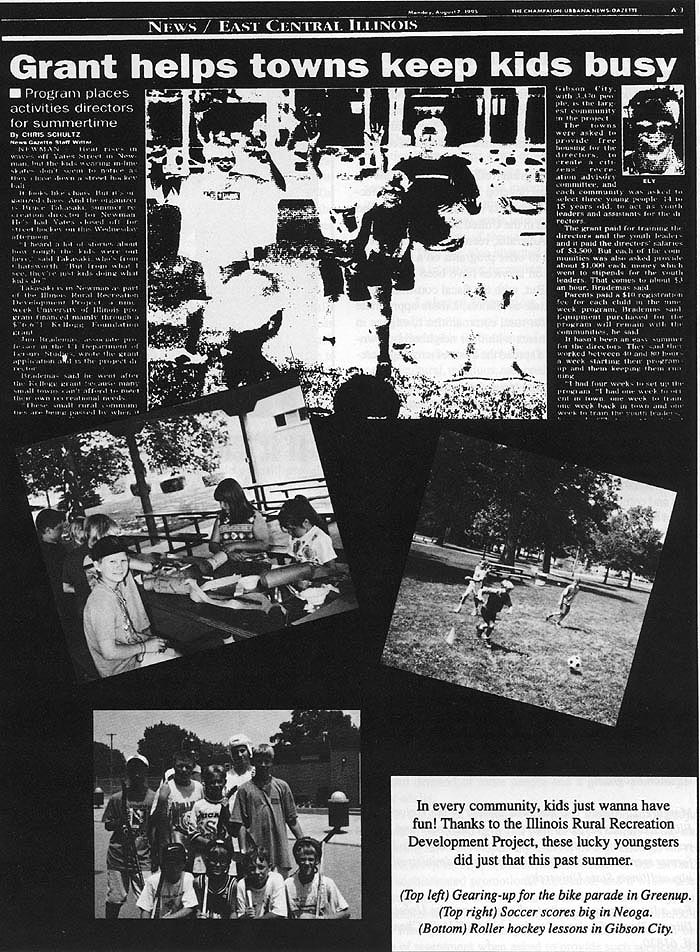 |
Home | Search | Browse | About IPO | Staff | Links |
 |
Home | Search | Browse | About IPO | Staff | Links |
|
Illinois Parks & Recreation November / December 1995 • Volume 26, Number 6  42 | Illinois Parks & Recreation | November/December 1995 Illinois Rural Recreation Development Project by Jim Brademas, Ph.D. The 1995 Illinois Rural Recreation Development Project (IRRDP) was designed to assist rural communities of under 5,000 population develop their recreation potential. Urban areas in Illinois have long enjoyed year-round public recreation programs. In rural communities, however, there is a lack of resources and professional leadership for the provision of general recreation services. The purpose of the Illinois Rural Recreation Development Project was to address the immediate unmet needs in small rural communities for summer recreation programs leading to long-term development for recreation services.
Pre-Program Planning The members of the city councils of Gibson City, Homer, Newman, Greenup and Neoga voted unanimously to adopt the program for the summer of 1995. The criteria for participation included a contribution of $ 1,000 and housing for the five summer recreation directors, the formation of a Citizen Recreation Advisory Committee made up of a cross-section of community residents, and the recruitment of three youths between the ages of fourteen and sixteen who would serve as "Youth Recreation Leaders" assisting the recreation director. Seven students from the Department of Leisure Studies were hired, five of whom were appointed as recreation directors, one as program manager and one as a research associate. Policy and procedure manuals were developed for both the recreation directors and the youth recreation leaders. Citizen Recreation Advisory Committee members filled out extensive inventories of the resources in their respective communities, detailing physical, program and volunteer resources. Two five-day training programs, held on the University of Illinois campus, were developed for recreation directors and youth leaders. Eight recreation specialists from the Champaign and Urbana Park Districts volunteered their time to conduct the training session, which covered arts and crafts, special events, environmental education, sports, games and working with special populations. University faculty conducted sessions on risk management, financial accounting, living in a rural community and general policies and procedures. The American Red Cross conducted sessions on first aid and CPR. The youth leader training was conducted by the recreation directors and project staff. Community Planning Recreation Directors were obligated to move to their cities four weeks prior to the beginning of the summer program to become familiar with the residents and available resources. The inventories compiled by the members of the advisory committees asked to define community needs and interests for a summer recreation program. Meetings were held with members of the advisory committees to review the inventories and to obtain first-hand information on needs and interests. Recreation directors met with students in the various schools to determine needs and interests. The training sessions and the specific summer recreation activities developed were centered around the results of these efforts.
Marketing Illinois Parks & Recreation • November/December 1995 • 43 parents through the local schools. The registration form contained a letter from the recreation director, a parent community recreation survey on their perception of recreation services, a two-page calendar of activities to be offered, a child registration form and a medical information form. All local newspapers were contacted with full details on the summer program. Each newspaper was sent resumes on the recreation directors which were subsequently printed. During the course of the summer, extensive newspaper coverage was given to the program including weekly calendars of activities, stories and pictures of various activities. Radio was also used to publicize the program.
Community Support
Youth Recreation Leaders
Evaluation of the Program
Citizen Recreation Advisory
Implications for the Future One city is exploring the possibility of establishing a park district. Inquires have been received from several communities wanting to participate in this program. There are 1,018 communities in Illinois with populations less than 5,000. The opportunity for expanded programming in rural areas appears to be unlimited. Funding remains a critical issue. The W.K. Kellogg Foundation grant was for one year. However, after viewing the program, the Kellogg representative offered the University of Illinois a continuation grant of $150,000 for two more years for retaining the five original cities and adding several more. Each city would have to contribute increased funds which they are willing to do. The critical point, however, is the need for the University of Illinois to contribute some matching funds. Over the three years it is anticipated that the Kellogg Foundation's contribution will be $226,761 and the cities' approximately $100,000. Some funding has been secured for the university's share, and several additional funding sources are being explored at this time. A video documentary on the Illinois Rural Recreation Development Project is available to rural communities interested in participating in the program and to universities for classroom use. Please write to Dr. Jim Brademas, University of llli- 44 • Illinois Parks & Recreation • November/December 1995
Illinois Parks & Recreation * November/December 1995 • 45 |
|
Sam S. Manivong, Illinois Periodicals Online Coordinator |